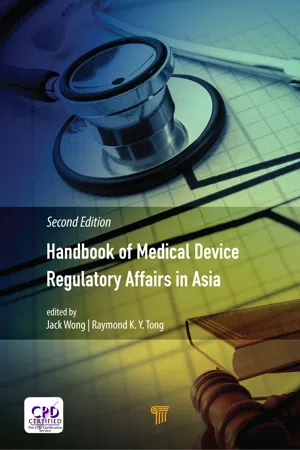![]()
Contents
Preface
1. How to train university students in regulatory affairs
Raymond K. Y. Tong
1.1 Introduction
1.2 A sample of regulatory affairs exercises for students
1.2.1 Background
1.2.2 Lifelong learning
Part 1: Introduction
2. The evolution of the regulatory professional: Perspectives on the skill sets and capabilities that will define the next generation of regulatory professionals
David Martin and Neil Lesser
2.1 Introduction
2.2 Drivers of change
2.3 Historical role and skill set of a regulatory professional
2.4 Changing role and skill set of the regulatory professional
2.5 Develop as a center of intelligence
2.6 Advance toward strategic relationship management
2.7 Develop as a strategic business partner
2.8 Conclusion: What will it take to get there?
3. The role of the Asia regulatory affairs team in relation to the commercial team and other departments
Fredrik Dalborg
3.1 Introduction
3.2 Key trends in the Asia medical device industry
3.3 The role of the asia ra team in a global medical device organization
3.4 Coordination between commercial teams and RA teams
3.5 The role of the RA team during the different stages of a product life
3.5.1 Product development
3.5.2 Market introduction
3.5.3 Product maintenance
3.5.4 Product phase-out
3.6 The RA professional: A trusted advisor
3.7 Summary
4. Commercial sense and what it means for a regulatory manager or executive
Annie Joseph
4.1 Know the basics
4.1.1 Marketing or commercial plan
4.1.2 Priority products and how they are ranked in the company
4.1.3 Know your commercial people
4.2 Maintain a healthy communication
4.3 Be proactive and part of the solution
4.4 Remain the expert and provide clarity to the organization
4.5 Be a champion for new product launches
5. Medical device regulatory strategy: Product development and product registration in Asia and globally
May Ng, Martin Ng, Ray Soh, Fadzlon Yunos, and Stephen Hsu
5.1 Introduction
5.2 Information in regulatory strategy
5.2.1 Device name
5.2.2 Device description
5.2.3 Intended use
5.2.4 Country of interest
5.2.5 Device classification
5.2.6 Product registration or conformity assessment route and its approval timeline
5.2.7 Technical documentation requirement
5.2.8 Quality management system requirement
5.2.9 Clinical assessment
5.2.10 Reimbursement assessment
5.3 Conclusion
6. Regulatory affairs as a business partner
Claudette Joyce C. Perilla
7. Introduction to regulatory affairs professionals’ roles
Dacia Su
8. What it means to be a medtech regulatory journalist
Amanda Maxwell
9. Affordable access to medical devices in developing countries
Rosanna W. Peeling and Tikki Pang
9.1 Introduction
9.2 Why is affordable access to medical devices important for developing countries?
9.2.1 Emergency preparedness
9.2.2 Efficiency and effectiveness of health systems
9.2.3 Health equity
9.3 Case studies
9.3.1 Delay in eligibility to treatment for HIV
9.3.2 Delay in access to early diagnosis of tuberculosis
9.3.3 Misleading claims of test performance for dengue rapid tests
9.3.4 Case Study—Access versus performance: Basis for FDA approval of the first over-the-counter rapid HIV test in the united states
9.3.4.1 Background
9.3.4.2 Performance expectations
9.3.4.3 Risk benefit analysis
9.4 The way forward
10. Regulatory specialists in medical devices in Europe: Meeting the challenge of keeping current in a changing environment—How TOPRA supports professionals in a dynamic industry
Lynda J. Wight
10.1 The European MedTech Environment
10.2 What Is TOPRA?
10.3 Why be a TOPRA member?
10.4 What support is offered?
10.4.1 Competency frameworks
10.4.2 Training and development
10.4.3 Education
10.4.4 Networks and collaborations
10.4.5 Information
10.5 Looking to the future
Part 2: Medical Device Safety and Related ISO Standards
11. Biomedical Devices: Overview
Piu Wong
11.1 Historic aspect of medical devices
11.2 Biomedical market environment
11.3 Orthopedics
11.3.1 Market
11.3.2 Materials
11.3.3 Biocompatibility
11.3.4 Fabrication
11.3.5 Polyethylene fabrication
11.4 Vision care
11.4.1 Market
11.4.2 Diagnostic devices
11.4.3 Treatment
11.5 Diabetics
11.6 Obesity
11.7 Vascular disease
11.8 Concluding remarks
12. Labeling, label, and language: A truly global matter
Evangeline D. Loh and Jaap L. Laufer
12.1 Introduction
12.2 Definition of labeling
12.3 Elements of labeling
12.4 Risk management, clinical evaluation and labeling: The core triangle for safe and effective use of the device
12.5 Labeling and promotion
12.6 e-Labeling, Web Sites, Internet, and Social Media: A Brave New World for Labeling
12.7 Language, language level, and intended user
12.8 Conclusion
13. Regulatory Affairs for Medical Device Clinical Trials in Asia Pacific
Seow Li-Ping Geraldine
13.1 Introduction
13.2 Medical Device Clinical Trials versus Pharmaceutical Clinical Trials
13.3 Regulation of Clinical Trials
13.4 Country Regulations
13.4.1 Australia
13.4.2 China
13.4.3 Hong Kong
13.4.4 India
13.4.5 Malaysia
13.4.6 New Zealand
13.4.7 Singapore
13.4.8 South Korea
13.4.9 Taiwan
13.4.10 Thailand
13.5 Moving Ahead as Regulatory Affairs Professionals
14. Medical Device Classification Guide
Patricia Teysseyre
14.1 How to Carry Out Medical Device Classification
14.1.1 Scope
14.1.2 Definitions
14.2 Main Classifications
14.2.1 Medical Devices
14.2.2 Active Devices
14.2.3 IVD Devices
14.2.4 IVD Case Study
14.2.4.1 US FDA
14.2.4.2 Canada
14.2.4.3 EU
14.2.4.4 Singapore
14.3 Medical Device Classification: Practical Examples
15. ISO 13485:2003/2016—Medical Devices—Quality Management Systems—Requirements for Regulatory Purposes
Gert Bos
15.1 Introduction
15.2 Background and Origins of ISO 13485:2003
15.3 Quality Management Systems
15.4 ISO 9000 and ISO 13485 Quality Management System Family of Standards
15.5 Global Regulatory Footprint of ISO 13485:2003
15.6 Implementing an ISO 13485:2003 Quality Management System
15.7 Process Approach
15.8 Planning the Implementation
15.9 Scope, Exclusions, and Non-Applicability
15.10 Document Control
15.11 Record Completion and Control
15.12 Management Responsibility
15.13 Resource Management
15.14 Product Realization
15.15 Risk Management
15.16 Design and Development
15.17 Purchasing and Supplier Control
15.18 Production and Service Provision
15.19 Monitoring and Measuring, Including Internal Audits and Management Review
15.20 Control of Non-Conforming Product
15.21 Analysis of Data
15.22 Improvement: Corrective Action and Preventive Action
15.23 Purpose and Goal of ISO 13485:2003 Certification
15.24 Achieving Certification and Continuing to Maintain Certification
16. ISO 14971: Application of Risk Management to Medical Devices
Tony Chan and Raymond K. Y. Tong
16.1 Introduction
16.2 The Foundation of a Risk Management Framework: Policy, Plan, Team, Process, and Documentation
16.2.1 Policy
16.2.2 Plan
16.2.3 Team
16.2.4 Process
16.2.5 Documentation
16.3 The RM Process
16.3.1 Analyze Risk
16.3.2 Evaluate Risk
16.3.3 Contr...
